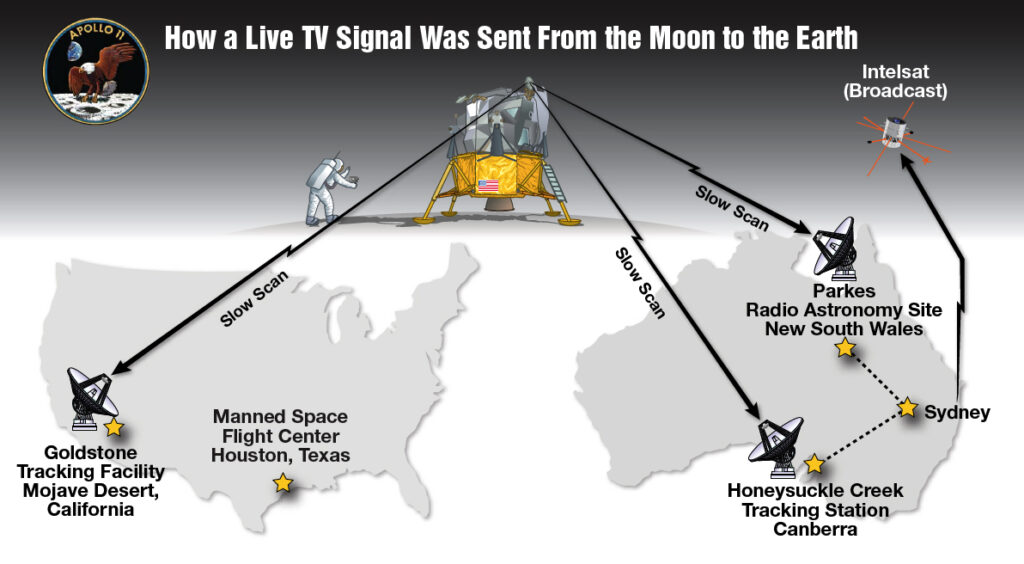
On the 20th of July, 1969, Apollo 11 landed on the Moon. 600 million people around the world watched as Neil Armstrong took mankind’s first steps onto the Lunar surface.
This moment captured the excitement of a generation and fulfilled President Kennedy’s goal of landing a man on the Moon by the end of the decade.
But how did NASA broadcast moon landing live from the Moon all the way to a record amount of people back on Earth?
In the early 60’s, NASA began working on the rocket and spacecraft that would eventually take humans to the Moon.
Read: SPACEX AND NASA TARGETING OCTOBER FOR NEXT CREW DRAGON LAUNCH
At the time, America had only sent a handful of astronauts into space, and no human had ever left Earth’s orbit.
This ambitious plan to send humans to the Moon was met with a lot of skepticism and NASA knew that live video of the astronauts walking on the Moon would be crucial for the mission’s credibility.
NASA contracted electronics company ‘Westinghouse’ to design and manufacture a small black and white camera that would be capable of capturing man’s first step on the Moon.
This camera would need to operate on a mere 7-Watt power source and be able to survive the harsh radiation and extreme temperatures found on the Moon’s surface.
Most importantly, the Lunar Module would need to be able to send the live video feed all the way back to Earth, along with the other radio and telemetry data that was already being sent back.
NASA realized that the Apollo missions would require a brand-new communications system in order to send data back from the Moon.
They developed a system called “Unified S-band” which could send: telemetry, command, voice and television data using different frequencies but combined into a single antenna.
However, even with this new system, there wasn’t enough bandwidth available for a standard 525-line video camera.
In order for the video feed to fit into the downlink, Westinghouse developed a slow-scan camera which transmitted just 325 scan lines at a mere 10 frames per second.
This camera would be connected to the Lunar Module via an electrical cable, allowing it to be moved around the landing site.
The video signal would be transmitted from the Lunar Module’s antenna back to a tracking station in Australia where NASA would convert the image into a standard broadcast signal.

That signal would then be transmitted up to a communications satellite and back down to mission control in Houston where they would broadcast it to the rest of the world.
However, the challenges of filming on the Moon didn’t stop there. The incredibly high contrast between the Lunar surface and the darkness of space would make capturing a clear image on the Moon extremely difficult.
To solve this problem, Westinghouse used a piece of classified technology which they had developed for the Department of Defense.
They had developed a special low-light imaging tube which was used on jungle surveillance cameras during the Vietnam War.
This could capture moving objects at low light levels without completely blurring the image. As the first manned Apollo missions loomed ever closer, the camera was ready and it was on Apollo 9 where it would go through its first and only test.
Read: SPACEX TO SET UP A BASE ON MARS! HERE’S WHAT THEY PLANNED TO DO FIRST.
The camera was placed on the Lunar Module and the mission successfully tested the camera along with the communication system.
The camera’s next task would be capturing man’s first step onto the Moon. 20th of July 1969, Apollo 11 touched down on the Moon.
With the camera placed on the side of the Lunar Module aiming towards the ladders, Buzz Aldrin hit a circuit breaker from inside the cabin to turn on the camera.
At the start of the broadcast, the footage appeared to be upside down. Video operators in Australia who were handling the signal quickly inverted the image to fix this issue, just in time for Neil stepping onto the Moon.
There was a great deal of contrast in the image and a lot of detail was lost through the conversion process, but the footage clearly captured one of the most historic moments in history.
The camera performed its job perfectly throughout the mission and remains on the Moon to this day. Future Apollo missions used a more advanced version of the camera which filmed in color and had better low light performance.
Apollo 15, 16 and 17 cameras were also placed onto the Lunar rover. Once the Astronauts were leaving the Moon, they parked the rover at a distance and a camera operator back at mission control would command the camera to tilt up, following the astronauts as they left the Moon’s surface.
So, although we have never been back to the Moon, we can appreciate the effort that went into capturing these historical moments in a way that we will cherish forever.
And when we do eventually return to the Moon, the advanced camera technology that we have today will allow us to capture the moment with even more beauty.
Additional Resources:
